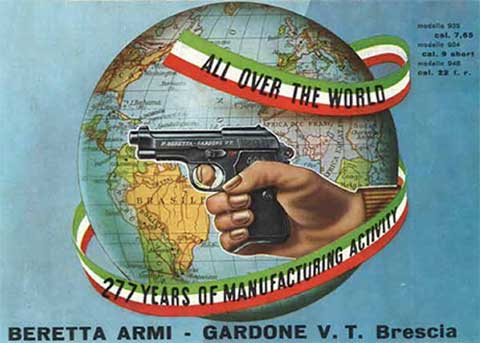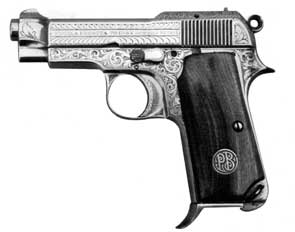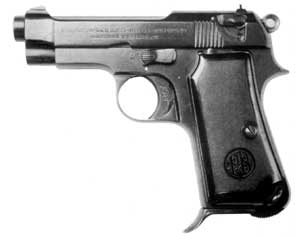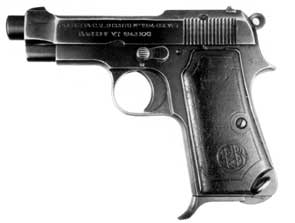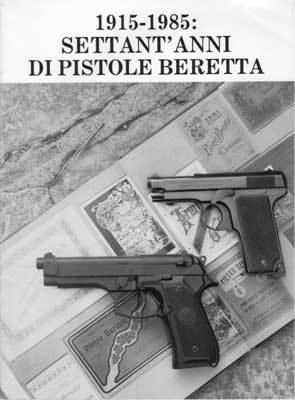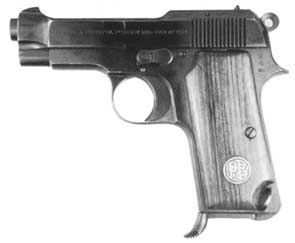 |
Model
1931 in its commercial version. |
The 1923 model, however, was not officially
adopted by the armed forces, thereby raising the problem
of having to create a new product that would attract
the interest of the military.
Out
of this came the Model 1931, a gun with the excellent
mechanical features of the 23 in a more compact design
which was also much lighter since it was designed for
the classic Browning 7.65 cartridge. This pistol can
be considered as the forerunner to the very famous Model
1934, from which it differed in only three ways: the
line of the handgrip; the grips themselves, which were
made of wood; and mechanically in the lack of half-cock
on the hammer.
As
usual, there is no documented evidence available about
production of these guns, although we know that it was
rather limited and ceased by 1935 with the appearance
of the Model 1935 in the same calibre. A number of Model
1931 s were acquired by the King's Navy, while another
quantity, presumably very few, were sold to the civilian
market. The serial numbers seem to start from 400.000,
and one example from 1933 of the civilian model which
we have examined was numbered just under 402.000, while
another example from 1934 was numbered above 406.000. |
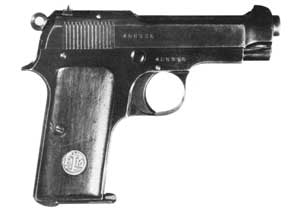 |
Beretta
model 1931 pistol in the version for the Italian King's
Navy |
The
guns manufactured for the Navy are easily recognised
by the medallion applied to the grips, bearing the seal
RM. The civilian pieces still sport the classic medallion
with the monogram 1313, together with the stamp from
Apparently in 1932, but it is possible this happened
one or two years later, a new version of the Model 1931
appeared, modified with a more comfortable and functional
handgrip.
The
few surviving examples of this gun show a clearly visible
correction in the numerals on the left side of the slide,
where we find the description «Mo 1932»,
with the number 2 obviously stamped over an existing
number l. We can assume from this that the gun was not
in production, but made in small numbers as experimental
prototypes or as samples to supply to the military commissions
which at the time were searching for a new pistol for
the Italian Armed Forces. In effect, the Model 1932
appears identical to the future Model 1934, which was
officially adopted by the King's Army. The only difference
was in the grips, which were made of wood instead of
bakelite, but this sort of modification is quite normal
in an experimental gun.
It
is also known the existence of some pistols which, while
bearing strict resemblance to the Model 1932, are marked
as Model 1931. This creates some confusion but considering
that ali of this anomalous guns are in the 7.65 calibre
we can reasonably assume them as provisional variants
in development of the final Model 1935 from the original
Model 1931.
|
|
An
engraved and nickel plated model 1931 pistol. |
Apart
from the now classic 7.65, the Model 1932 was chambered
for a cartridge which Beretta was to use for the first
time, the .380 ACP, one of the numerous creations of
J.M. Browning. The cartridge was renamed the 9 “corto”
(short) in Italy, evidently to avoid confusion with
the 9 Glisenti, which had a case that was longer by
a few millimetres and was consequently nicknamed the
9 “lungo” (long) - all of which contributed
to the already notable confusion among the 9mm calibre
cartridges intended for use in automatic pistols.
As
already mentioned, during the first half of the 1930s
the new Berettas were subjected to a series of tests
by the armed forces and the police. During the course
of these tests several modifications were made, including
the introduction of half-cock. Various experiments were
carried out, including the manufacture of one lot of
650 pistols furnished with a safety on the striker,
one pistoi which was definitely abandoned. It seems
that comparisons were made with the Walther PP, but
in the end the Beretta pistol was adopted under the
name of «Modello 1934 calibro 9 corto».
The
adoption of this new 9mm pistol by the army did not
impede the development of the 7.65 calibre version,
the Model 1935, which was supplied to the navy and the
air force, and continued to be produced independently
of the larger calibre model. |
One
of the 650 (very rare), Model 1934 pistols fitten with
firing pin safety. |
|
It
is interesting to note how these two pistols, which
are apparently identical, have differences in dimensions
which make it impossible to exchange essential components
such as barrels or magazines.
It is also interesting that while the Model 34 was considered
a completely new gun and numbered separately (the numbers
seem to start from 500.000), the Model 35 was considered
a new version of the 1931 model and was numbered in
the same series as it's ancestor (this can be deduced
from analysis of the serial numbers). It should be added
that a Model 1937 exists, although in fact it is rather
rare. This is nothing more than the commercial version
of the 1934, and differs only in the writing on the
slide and the lack of military stamps. Naturally, we
find the stamp of the “Banco di Prova” in
their place.
At
the end of the 1930s Beretta began experimenting with
light-alloy frames for its pistols. In the years after
the war the 7.65 calibre version of this pistol enjoyed
some commercial success, while the 9mm version proved
altogether unsatisfactory and continued to be produced
exclusively in steel.
The
Beretta Model 1934 (like the 35) was a top-grade gun,
and was practically without rivals in its functional
class. Despite criticisms due for the most part to the
Italian vice of denigrating its own national product
and revering the import, a Beretta automatic pistol
was an attractive spoil of war for the soldiers of all
armies that crossed our land during the tragic years
of the last war.
|
|
A
model 1934 pistol built in 1943. The weapon still presents
a good finish, althought it was built during the war. |
|
Its fundamental attributes were its
dependability and portability, qualities which are essential
for a soldier who depends on his pistol for his very
life.
To
this must be added the minimal cost and simplicity of
any repairs that were on rare occasions required. Naturally
we cannot dismiss the limitations of this gun, which
did not use very powerful ammunition (by military standards),
and which did not allow very high standards of marksmanship.
In fairness, however, these drawbacks are only apparent
when the pistol is compared with larger, costlier and
more complicated guns, which in the end proved to be
less efficient. it is also a telling point that these
Beretta models are still sought-after many years after
going out of production, and many thousands of these
guns which factory withdrew from the armed forces at
the advent of more recent models were quickly absorbed
by the civilian market after a complete overhaul.
The
production of the 34 and above all the 35 continued
for the duration of the war, and the evolution of the
conflict had a significant influence on the quality
of the guns, especially those produced in 1944 and 1945.
Fortunately, the simplicity of these pistols meant that
any defect in production affected only their external
finish, and not their performance or safety. |
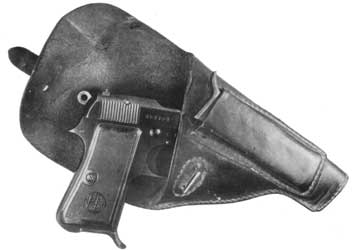 |
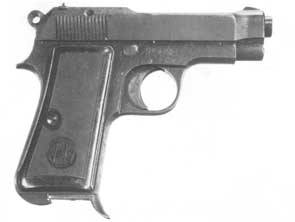 |
A
model 1935 pistol Built in 1941. This gun shows the
«Regio Esercito» (Royal Army) markings although
it is in 7,65 calibre instead of 9 mm, which is what
the army usually used. Below, the same pistol is shown
in its service holster. |
Model
1935 pistol as produced during last months of second
world war. These guns have no external finish and show
deep machining marks. Serial number and calibre indication
are the only markings of this weapon and are badly impressed
on frame just above trigger guard. |
It
is interesting that during the time that the production
fell into German hands the criteria for serial numbers
changed. The simple progressive numbers which Beretta
had always used was replaced by a mixed code of letters
and numbers - typically German. Naturally, this does
not help any investigation into wartime production at
Beretta. We have ascertained, however, that the Model
35 was not produced exclusively at the Beretta plants.
Several examples exist with the writing «Pistola
Beretta Cal 7.65 M35 S.A. Armaguerra-Cremona 1944»,
together with the usual mixed German numbering. Unfortunately
we have no data regarding this production, which can
be defined as external. We cannot tell whether the pistols
were produced at other plants as well, or indeed how
many of them were made. |
| The
Beretta 1935 model by Armaguerra in Cremona. Eccept for
the slide markings the weapon does not present differences
worth of any noticie. |
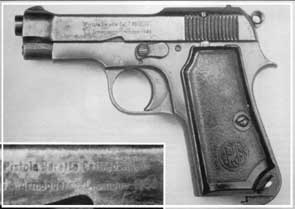 |
 |
| Interesting Suppressor & Interface Patented by Beretta for the model 1934, Guns.com imported some of those. |
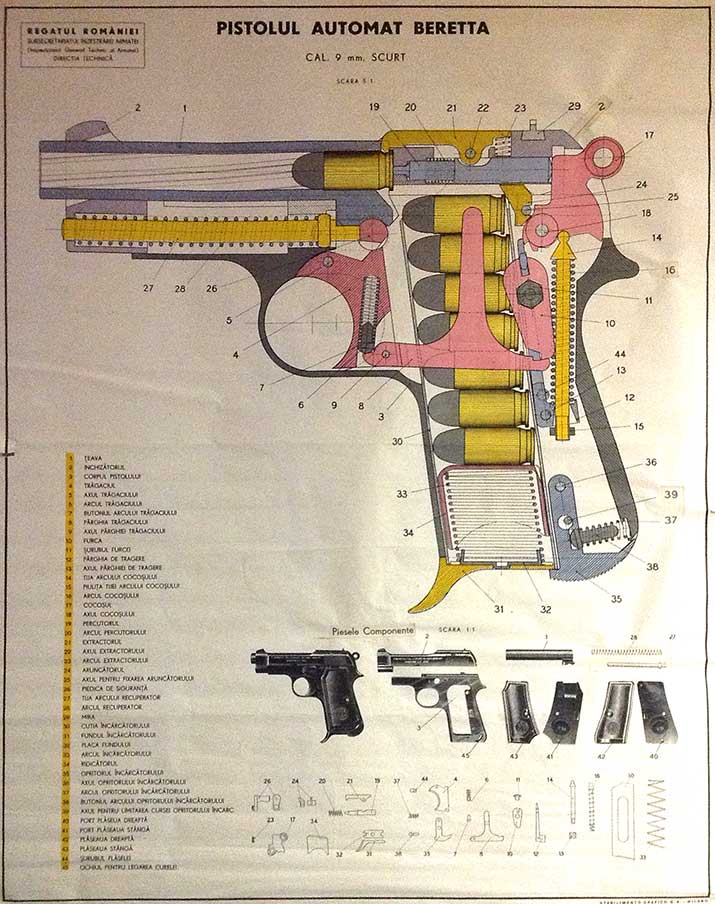 |
| |
| SERIAL NUMBERS RANGE |
Model 1934 cal. 9C / .380ACP
Start
/ end of production: from 1934 to 1980 (1991*)
Quantity produced about 1,080,000
Start
- End - Serial numbers
1934 - 1942 - from about 500073 to 999996
1934 - 1942 - from 1 to about 40000
1943 - 1945 - from F00001 to F99997
1943 - 1945 - from G00001 to G57486
1943 - 1945 - from 0001AA to 9997AA
1943 - 1945 - from 0001BB to 9971BB
1946 - 1949 - from C00001 to C99998
1949 - 1954 - from D00001 to D99999
1954 - 1967 - from E00001 to E95760
1967 - 1973 - from F50001 to F61693
1970 - 1975 - from G00007 to G49620
1972 - 1974 - from H00001 to H25000
1971 - 1980 - from T 1 to T 10217
1991* onwards from A28530Y
|
Model 1935 cal. 7.65 / .32ACP
Start
/ end of production: from 1935 to 1967
Quantity produced about 525,000
Start
- End -Serial numbers
1935 - 1959 from about 411000 to 923048
1962 - 1963 from A10001 to A14130
1966 - 1967 from H14131 to H14673
|
|
